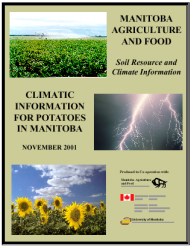Climatic Information for Potatoes in Manitoba
An Assessment of the Long-term Climatic Factors Important for Potato Production in Manitoba
Introduction
The major climatic factors involved in potato production are heat and moisture availability. Heat availability across Manitoba will determine where potatoes will reach maturity as well as affect yields achieved in the potato growing regions of the province. Moisture availability will also significantly impact potential yields. In an attempt to describe these factors for Manitoba the following maps contain such information as occurrence of the last spring frost, occurrence of the first fall frost, length of the frost free period, p-day accumulations, growing season precipitation, crop water demand and crop water deficit. These maps have been derived from long-term weather data collected across Manitoba.
|
 |
Spring Frosts, Fall Frosts, and Frost Free Periods
Frost occurs at temperatures of 0 ° C or colder. Manitoba is located near the northern limit for agricultural production and as a result the occurrence of frost is one of the most limiting factors for crop development. Unusually late spring frosts or early fall frosts can have serious economic consequences. The average date of the last spring frost is particularly important because it determines the date of planting. In addition, a late spring frost can do serious damage to young plants. The date of the first fall frost determines the end of the growing season for most crops. A particularly important period is the time between the first spring frost and the last fall frost, defined as the frost free period. This is the time available for crop production.
Spring Frosts
The average date (50% chance of occurrence) of the last spring frost shows that two regions within Manitoba have the most favourable conditions for early planting. After May 19 there is less than a 50% chance of frost in the Portage la Prairie and Langruth regions, and in the Pilot Mound, Morden and Altona regions. In most other areas of Manitoba, the last spring frost occurs, on average, after May 24. On higher elevations above the Manitoba escarpment, the average date of the last spring frost is somewhat later. The central Interlake and the south-eastern regions of Manitoba can expect frost during the first week of June in one out of every two years.
Fall Frosts
Areas susceptible to late spring frost also risk an early fall frost. The earliest average first fall frosts (August 27 to September 1) are in the central Interlake, Riding Mountain and south-east regions of Manitoba. Likewise, the latest occurrence of first fall frosts (from September 16 to September 26) are in those areas with the earliest occurrence of last spring frosts. These regions are the Portage la Prairie, Morden, Pilot Mound, Morris, Winnipeg and Red River Valley regions.
Frost Free Periods
The frost free period determines the time available for crop production. As such, it also determines what crops can be grown in a region. The average frost free period is the shortest near Riding Mountain at 75 days. The longest average frost free period (125 to 135 days) is in the Morden, Portage la Prairie and Selkirk areas.
Physiological Days (P-Days) for Potatoes
Potatoes possess very specific heat requirements. The minimum temperature for growth and development is 7 ° C (45° F) and the most rapid growth and development occurs at 21 ° C (70 ° F). The growth rate decreases with increasing temperature above 21 ° C (70 ° F) and finally stops at 30 ° C (86 ° F). From this information P-days can be calculated. The highest average accumulation of P-days, 900 to 950, occurs in the very southern part of the Red River Valley, extending south of Dominion City through to Altona and northwest of Morden. There are also a few smaller areas to the east of and around Portage la Prairie, Selkirk and Great Falls. Most of the area to the south and east of a line from the southern end of Lake Manitoba to a point just to the west of Melita accumulates 850 to 900 average annual P-days. The remainder of the province has fewer than 850 P-days. It is important to note that not all of the most southerly parts of the province have the highest P-day accumulations. For example, the area to the south and west of Melita does not have any more P-days than the area near Carberry, some distance to the north. In fact, it is elevation and not latitude that seems to be the most important factor influencing P-days. Going west from the Red River along the U.S. border, one finds areas of low P-days near Pilot Mound in the municipality of Louise and the Turtle Mountain region near Boissevain. Both of these areas are at a higher elevation than nearby areas. At these locations, the fall frosts occur earlier, putting an end to the growing season, the date at which P-day calculations stop.
Moisture
One of the major factors in potato production is the seasonal soil moisture balance under a potato crop. Several climatic and soil factors affect this balance, such as: soil texture, soil moisture status at the start of the growing season, precipitation, crop water demand and water deficit. The data presented here is based on calculations made for soil moisture status under a crop of corn as no such data is available for potatoes. Like potatoes, corn is a long season crop requiring a large amount of heat and moisture to produce adequate growth and yield. As such, data for corn was used to provide an approximation of the soil moisture status for potatoes.
Produced in Co-operation with:
Manitoba Agriculture, Food and Rural Initiatives
University of Manitoba, Faculty of Agricultural & Food Sciences
Environment Canada, Atmospheric Services

